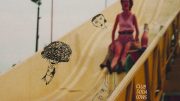Dallas Good, singer and guitarist of Toronto-based band the Sadies, passed away on Feb. 17. As described in the announcement, it was a sudden death of natural causes at the tragically young age of 48.
“A son, a brother, a husband, a friend, a bandmate, a leader, a force to be reckoned with, we have no words for the shock we are all feeling,” the band wrote on Facebook following Good’s passing.
Dallas Good and the Sadies always felt like an immovable object, a fixture of Canadian music that would always be there. They were constantly on the road, constantly releasing music and working with other artists.
It would be reductive to label the Sadies with any one genre. Its music combined so many interconnected genres in a completely idiosyncratic, unique way. Certainly, the band drew largely from the alt-country scene that emerged in the ’90s, but it also took from punk, garage rock, psychedelic, bluegrass and really all sorts of western, folk-derived music.
Dallas and Travis Good’s dueling guitars gnash and twang and drawl and howl all at once, biting but awash in languid reverberation. Their rhythm section has a Crazy Horse-ish ramshackle quality, with this lived-in groove all their own. They’re like if Gram Parsons joined the Velvet Underground or if the Band was handed a copy of Marquee Moon: music firmly rooted in western idioms and tradition but transgressive, stark and aggressive enough to feel vital despite a complete disregard for trendiness or mainstream recognition.
The group was an unstoppable force for over 20 years, never changing, always doing what they did best and what no one else could do. Beyond their own singular greatness, the Sadies were also prolific collaborators, working with legends like Neko Case, Gord Downie, Garth Hudson, Kurt Vile and Neil Young. This is to say they were real musician’s musicians, never able to overcome their cult status but gathering respect from everyone they crossed paths with, as evidenced by the outpouring of grief with the news of Good’s passing.
Good himself was a strangely mythical figure. He had a face like an old west outlaw, framed by scraggly sideburns, and he and his brother Travis always appeared in suits, often adorned in western embroidery. Like the band’s music, Good was a man out of time, with his towering, gaunt physicality and completely unshakeable stage presence. Stone-faced and intense, he was a classic rock ’n’ roll figure, with an air of perpetual cool.
Without Good, the future is uncertain, but the Sadies’s legacy will undoubtedly last forever.




